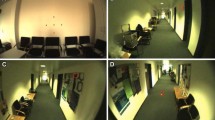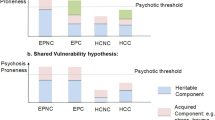Abstract
Objectives
To examine the effect of chronic exposure to methylmercury on eye movements (pursuit, fixation and dynamic saccades) in Cree subjects from Northern Quebec.
Methods
Eye movements were recorded in a group of Cree subjects (n=36) exposed chronically to methylmercury, a group of patients with Parkinson’s disease (PD) (n=21), and a group of control subjects (n=30) by use of an infrared eye-movement recording system. Pursuit, fixation, and prompted and remembered saccades were recorded twice for both eyes in the horizontal and vertical axes. Blinks were removed, and data were calibrated.
Results
Analyses of variance revealed significant differences for all characteristics examined for fixation and pursuit, and for some characteristics in dynamic saccades. These differences arose sometimes from the Cree group, sometimes from the PD group and sometimes from both groups.
Conclusions
The results suggest that eye movements of Cree subjects exposed to methylmercury are qualitatively different from those of both control subjects and patients with PD. Comparisons between more-exposed and less-exposed Cree subjects matched for age with control subjects also showed significant differences for fixation, pursuit and dynamic saccades. The average scores of the more-exposed group were clearly separated from those of the less-exposed and control groups for characteristics of fixation and pursuit, and for accuracy and sharpness of prompted saccades. This trend was less clear in other results where a possible effect of mercury exposure could not be distinguished from a possible cultural effect. Further studies should focus on the most discriminating characteristics for the Cree group, such as measures of accuracy and coherence in all tests and sharpness of saccades.





Similar content being viewed by others
References
Bahill TA, Brockenbrough A, Troast BT (1981) Variability and development of a normative data base for saccadic eye movements. Invest Ophthalmol Vis Sci 21:116–125
Barbo E, Guehl D, Titcombe M, Beuter A (2001) Corrélation entre l’évaluation qualitative et quantitative du tremblement dans la maladie de Parkinson. Congrès de l’Association Canadienne Francaise de l’Avancement des Sciences, Sherbrooke, May 2001
Beuter A, Edwards R (1998) Tremor in Cree subjects exposed to methylmercury: a preliminary study. Neurotoxicol Teratol 20:581–589
Beuter A, de Geoffroy A, Edwards R (1999) Analysis of rapid alternating movements in Cree subjects exposed to methylmercury and in subjects with neurological deficits. Environ Res 80:64–79
Bloomfield P (1976) Fourier analysis of time series: an introduction. Wiley, New York
Brockwell PJ, Davis RA (1991) Time series: theory and methods, 2nd edn. Springer, New York
Bronstein AM, Kennard C (1985) Predictive ocular motor control in Parkinson’s disease. Brain 108:925–940
Crawford T, Goodrich S, Henderson L, Kennard C (1989) Predictive responses in Parkinson’s disease: manual keypresses and saccadic eye movements to regular stimulus events. J Neurol Neurosurg Psychiatry 52:1033–1042
Dodge R (1903) Five types of eye movements in the horizontal meridian plane of the field of regard. Am J Physiol 8:307–329
Dumont C, Wilkins R, Kosatsky T, Penn A, Lapierre S (1988) Recent changes in methylmercury exposure of the James Bay Cree of Quebec. Arctic Med Res 47 [Suppl 1]:168–174
Duval C, Beuter A, Gauthier S (1998) Fluctuations in tremor at rest and saccadic eye movements in subjects with Parkinson’s disease. Parkinsonism Relat Disord 3:195–205
Finkelstein Y, Vardi J, Kesten MM, Hod I (1996) The enigma of parkinsonism in chronic borderline mercury intoxication, resolved by challenge with penicillamine. Neurotoxicology 17: 291–296
Glaser JS (1999) Neuro-ophthalmology, 3rd edn. Lippincott, Williams and Wilkins, New York
Heide W, Kurzidim K, Kömpf D (1996) Deficits of smooth pursuit eye movements after frontal and parietal lesions. Brain 119:1951–1969
International Program on Chemical Safety (1990) Environmental health criteria 101: methylmercury. World Health Organization, Geneva, p 104
Kosatsky T, Foran P (1996) Do historic studies on fish consumers support the widely accepted LOEL for methylmercury in adults. Neurotoxicology 17:177–186
Leigh RJ, Zee DS (1999) The neurology of eye movements, 3rd edn. Oxford University Press, Oxford
Miller NR (1985) Walsh and Hoyt’s clinical neuroophthalmology, 4th edn, vol 2. Baltimore, Williams and Wilkins
Müller P, von Mühlenen A, Mendell L, Groner R (1990) A comparison of a new limbus tracker (OBER2), corneal reflection technique (ASL Eye View Monitor 1994), and electro-oculography. XVI International Rodin Remediation Scientific Conference: genetic and neurobiological influences in dyslexia. Boulder, Colorado, September 1990
National Research Council (2000) Toxicological effects of methylmercury. National Academy Press, Washington, DC
Paré M, Hanes DP (2003) Controlled movement processing: superior colliculus activity associated with countermanded saccades. J Neurosci 23:6480–6489
Rascol O, Clanet M, Montastruc JL, Simonetta M, Soulier-Estève MJ, Doyon B, Rascol A (1989) Abnormal ocular movements in Parkinson’s disease. Brain 112:1193–1214
Rashbass C (1961) The relationship between saccadic and smooth tracking eye movements. J Physiol 159:326–338
Robinson DA (1965) The mechanics of human smooth pursuit eye movement. J Physiol 180:569–591
Timmer J, Gantert C, Deuschl G, Honerkamp J (1993) Characteristics of hand tremor time series. Biol Cybern 70:75–80
Ventre J, Zee DS, Papageorgiou H, Reich S (1992) Abnormalities of predictive saccades in hemi-Parkinson’s disease. J Neurophysiol 53:19–37
Versino M, Hurko O, Zee DS (1996) Disorders of binocular control of eye movements in patients with cerebellar dysfunction. Brain 119:1933–1950
Westheimer G (1954) Mechanisms of saccadic eye movements. Arch Ophthalmol N Y 52:710–724
White OW, Saint-Cyr JA, Tomlinson DR, Sharpe JA (1983) Ocular motor deficits in Parkinson’s disease, II. Control of the saccadic and smooth pursuit systems. Brain 106:571–587
Acknowledgements
The authors wish to thank all the participants. They also wish to thank members of the Cree Board of Health and Social Services of James Bay and especially Dr Charles Dumont, and the neurologists (Drs Serge Gauthier and Michel Panisset) who performed the clinical examinations.
Author information
Authors and Affiliations
Corresponding author
Rights and permissions
About this article
Cite this article
Beuter, A., Edwards, R. Effect of chronic exposure to methylmercury on eye movements in Cree subjects. Int Arch Occup Environ Health 77, 97–107 (2004). https://doi.org/10.1007/s00420-003-0480-3
Received:
Accepted:
Published:
Issue Date:
DOI: https://doi.org/10.1007/s00420-003-0480-3




